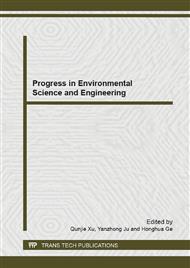p.1188
p.1194
p.1199
p.1205
p.1209
p.1213
p.1218
p.1223
p.1229
Oxidative Degradation of Dimethyl Phthalate (DMP) by Persulfate Catalyzed by Ag+ Combined with Microwave Irradiation
Abstract:
The removal of dimethyl phthalate (DMP), which is a pollutant of concern in water environments, was carried out by sodium persulfate (SPS,Na2S2O8) catalyzed by Ag+ combined with microwave irradiation. Effects of persulfate concentration, reaction time, microwave(MW) power and catalytic ion Ag+ on the degradation efficiency of DMP by persulfate were examined in batch experiments. The results showed that optimum Na2S2O8 concentration was 0.083mmol/L, and Ag+ concentration was 0.042 mmol/L. Increasing the MW irradiation time , persulfate concentration or Ag+ concentration might significantly accelerate DMP degradation. Catalytic ion Ag+ combined with microwave irradiation was an rapid method to activate persulfate, and thus to produce SO4− • which was a powerful oxidant and could degrade DMP effectively. About 80% of DMP and 70% of COD could be degraded in 140s under the conditions of 800W MW power.
Info:
Periodical:
Pages:
1209-1212
Citation:
Online since:
December 2012
Authors:
Keywords:
Price:
Сopyright:
© 2013 Trans Tech Publications Ltd. All Rights Reserved
Share:
Citation:


